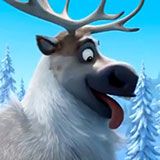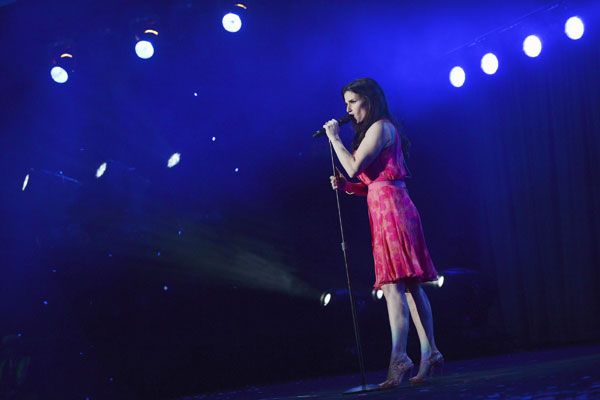Though the release of Disney's new animated feature film Frozen is still months away, it already has fans devoted enough to come in costume as lead characters Anna and Elsa when the company offered a special presentation at the D23 Expo on Saturday. Animator and presentation moderator Darrin Butters was thrilled to see the cosplayers' devotion and craftsmanship.
"Wow, you guys kind of worked with [the design team]! Welcome to the movie industry," he joked. Butters, along with directors Chris Buck and Jennifer Lee, producer Peter Del Vecho, art director Michael Giaimo, visual development artist Brittney Lee, and head of animation Lino DiSalvo offered fans both in and out of costume a special exclusive look at the film. Armed with fascinating concept sketches, "exploration" animation tests, and even some never-before-seen complete animation, the group showcased their very promising work.
Frozen, based on Hans Christian Andersen's story The Snow Queen, is a tale of two sisters. Anna is a warm and curious young princess voiced by Kristen Bell. Elsa, voiced by Wicked veteran Idina Menzel, is her emotionally distant older sister and the recently crowned ruler of Arundel, a kingdom Giaimo mentioned was based in the natural beauty and architecture of Norway.
In the first clip of completed animation shown, Anna meets Kristoff, the prince of a neighboring kingdom. The two have an instant connection and in a subsequent clip that contained both rough and complete animation, Elsa denies Anna permission to marry the prince. The ensuing fight reveals to the people of Arundel that Elsa was born with mysterious ice powers. Cast out, she freezes the kingdom's fjord and builds a castle of ice in the high mountains. Anna, with the help of an ice harvester named Hans and a snowman named Olaf (Josh Gad), must figure out a way to melt the ice covering the kingdom and her sister's heart.
The footage presented more than just the dramatic stakes of the film. Even in the rougher shots, the costume and background designs showcased a level of detail Giaimo takes a particular pride in. Showing stills of the art team's trip to Norway, he highlighted two elements he found most inspiring there: the stillness of the fjords and the country's exquisite nearly thousand-year-old stave churches.
"Even though it is a fantasy and even though it takes place in another world, it's important to ground the audience in something they can believe in," he explained. Of the fjords, he said, "they're incredibly majestic, beautiful and, in my opinion, the eighth wonder of the world." The fjords consist of incredible rock faces and planes of very calm water. "You have this drama next to something very calm, which is this very interesting counterpoint," he continued. Inspired by the setting, the design team prepared an amazing piece of concept art illustrating Arundel as a kingdom perched on the bank of a fjord.
The churches, made of wood, consist of tiered, slopping roofs with intricate design elements along the edges. Those facets inspired Giaimo to incorporate the design element in Arundel. The influence is readily apparent in the ultimate design of the city-state's castle exterior.
Combining the two touchstones, Giaimo noted the overall effect is a departure from most Disney kingdoms. "Usually, castles are up on promontories, this is just the opposite. It sits horizontally amongst the vertical," he explained. That inversion became a recurring theme in the visual language of the film.
The Norwegian decorative folk art known as "rosemaling." in which colorful embellishments are painted or inlaid onto interior walls, pottery and even clothing, found its way into the production as well.
"It can be very cursive and flowery, but it can also be very geometric and lineal," Giaimo said of the style. Once he saw examples of clothing with rosemaling, he knew it also had to be incorporated into the design scheme. "From a design perspective, [the clothes and architecture] can 'talk' to one another," he said. The overall effect helped create a fully realized culture.
Lee followed up on these ideas with an example of her design contributions. "Just as all the designs need to talk to each other, we designers need to work together," she said.
Lee, as part of the 15 member art department, worked to build the world of the film, from the largest visual aspects to the tiny details, like the rosemaling. She showed a slide of Elsa in her blue-on-blue Ice Queen gown.
"We wanted to show how we incorporated design into her cape; she wears a snowflake," she said. The choice allowed them to incorporate some of what they learned from rosemaling into Elsa's ice castle, an environment mostly composed in gradations of a single color.
Gaimio called the design phase of the film "extremely labor intensive," but thinks the stunning results, particularly the costumes, will be landmarks in the GCI arena. "Hopefully, it will be a great viewing experience for all of you, we can't wait for you to see it," he said.
Making those costumes designs and the characters wearing them come to life was the responsibility of Lino DiSalvo. It is a task known in the animation business as "head of animation." Walking out onto stage, DiSalvo noted the presentation was taking place as the animation team was completing their final day of production. As animators, their goal is to find what he called "truth in acting." Part of the development phase for the animators is finding ways to express the characters through their movements and facial expressions. The team worked with an acting coach to determine how each design would behave in the real world. In the case of Olaf, for example, actor Josh Gad came in and discussed his thoughts on the character. The animators also watched Idina Menzel perform Elsa's songs to get a sense of how to animate the character breathing between phrases.
Finding the truth in the characters also means deliberate choices. In Olaf, the team attempted to play him without the ability to bend his stick-arms at the approximate elbow point.
"What ends up happening is that the simplest thing becomes [complicated]. If you can't bend you arms and you need to scratch your head, you need to sort it out. So you'll see Olaf roll his head off or drop his head, pick it up, scratch it, drop it again and so on." That level of thought goes into every character, be they humans with normal joints, reindeer or horses.
DiSalvo showed some of the early "exploration" animation the team used to find the movement patterns that best fit each character.
"With Anna, we thought with her personality and background that she'd be kind of quick moving. We love the concept that she has squirrely movements," he explained as a loop of Anna having a snowball fight played behind him. Adding that Anna often reacts before she thinks, he showed a slide of the character's key facial expressions. Beyond movement, the team must also create a grammar of emotions for each character. The group then takes those expressions and key posses and makes further animation tests in full CG, something DiSalvo called "calisthenics." Once those keys expressions are agreed upon, it becomes a guide for each animator as they work on the final animation.
In taking a year to refine the characters' expressions, key poses and movements, DiSalvo mentioned a specific test would reveal the right combination and give them the character they want, but "you can never pinpoint where it will happen." Since the magic cannot be scheduled, this exploration process is purposely given a longer period so all the bugs are worked out before a single frame of final animation is composed.
That exploration period also helps the team determine the best camera angles for each character.
Illustrating the end result of all the work, DiSalvo unveiled a scene in which Olaf sings to his reindeer Sven. Though Sven cannot talk, his expressions mimic the lyrics Olaf composed for his companion. It is quite an effective example as Sven is revealed to have a personality that Olaf is keyed into. Even in this short scene, the qualities of the characters shine through.
Directors Buck and Lee, and producer Peter Del Vecho offered a few comments on the storyline. According to Del Vecho, Walt Disney wanted to adapt The Snow Queen, but his plans never came to fruition.
In offering more of the film's setup, Buck revealed that Elsa's ice powers hurt Anna when they were little girls. Their parents took them to magical stone trolls who told Elsa that these powers are tied to her emotions and that "there is beauty in her powers, but also great danger." The trolls also healed Anna and removed any memory of the incident. As they grow into the people shown in the clips, Anna attempts to get closer to Elsa, who has pushed her away in fear of hurting her again.
According to Lee, Anna grows into a person who "takes the negative of a situation and turns it into a positive," but is fed up with Elsa and longs for a connection when she meets Kristoff.
The film features songs by Kristen Anderson-Lopez and Robert Lopez of Avenue Q and Book of Mormon fame.
"With our songs in Frozen, we're going to take it a bit edgier than Book of Mormon," Buck quipped. The group showed a clip featuring an actual song from the film, in which Olaf reveals his wish to experience summer and do "whatever snow does" during that season.
During a brief audience Q&A, the group was asked why the film is not a closer adaptation of Andersen's Snow Queen, in which Anna is called Gerta and must save her friend Kai from the Snow Queen. Buck said that an earlier iteration of the project followed the original story, but "as we developed it more, we thought it would be more interesting if they were sisters." The emotional bond between them would amplify the conflict. "It just became a much more emotional story; the audience will root for them getting back together."
"The Snow Queen in the original story is not a well-drawn character, she's very symbolic," added Lee. "We had to discover who she was and what she would be like and the more we [talked], the more exciting it was to think about these two [as sisters]."
According to Buck, producer and Toy Story director John Lassiter offered the team a few words of advice after an early story reel screening. "When it was just the Anna story, he said, 'you haven't gone deep enough.'" Buck credited that comment with the impetuous to develop the Snow Queen into Elsa.
From story meetings to design drawings to final animation, the team offered fans a look at just how much work goes into making a film like Frozen, but the real test will be the audience response when it goes into release on Nov. 27.


